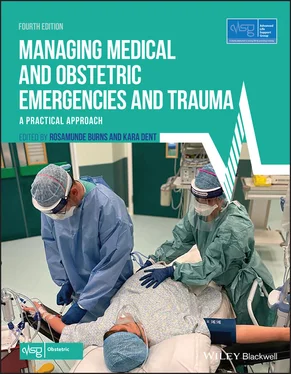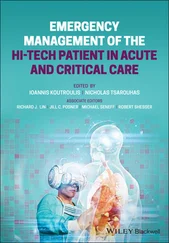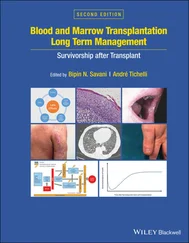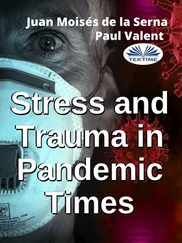Maintenance of adequate oxygenation is an important step in the resuscitation of women with sepsis. This includes a patent airway with adequate breathing and supplemental oxygen. Most patients in shock will ultimately need intubation and ventilation because of increased difficulty in breathing, development of acute respiratory distress syndrome (ARDS) or for primary underlying disease.
Use 20 ml/kg crystalloid as an initial bolus of fluids over 30 minutes whilst looking for haemodynamic improvement. Hypovolaemia is demonstrated when elevation of the legs transiently improves blood pressure. Recording of accurate fluid balance is essential.
Fluid balance is difficult in septic shock, as there will be an inevitable tendency of fluid to leak into the lungs as a result of increased capillary permeability, myocardial dysfunction, renal impairment and a low plasma oncotic pressure. If there is no improvement in the blood pressure following the fluid bolus, critical care referral is required.
In patients who remain hypotensive, despite adequate fluid resuscitation, early recourse to vasopressor therapy is recommended with invasive arterial and central venous pressure monitoring. The target blood pressure should be a mean arterial pressure of >65 mmHg.
Noradrenaline administered centrally is the vasopressor of choice but can be started peripherally if urgent, under guidance from the anaesthetic and critical care team. Adrenaline may be added if poorly responsive. Sensitivity to catecholamines is significantly altered in septic patients and they require much higher doses than in other clinical situations.
Early source identification and control of infection
On examination look for sources of infection that may require surgical drainage or surgical excision of infected tissue, and tailor the investigations to the history and examination findings. Mortality reports emphasize that the recognition of the genital tract as the source of infection is often delayed with over‐reliance on antibiotics to control the infection. Imaging is often delayed in those cases of women who die from sepsis and there is a reluctance to undertake surgical measures.
Identify source of infection as rapidly as possible; imaging and repeat imaging may be required
Closed‐space infections need surgical drainage, including evacuation of retained products of conception
In women with endometritis not responding to antibiotics, a septic pelvic thrombosis should be considered; these patients will require anticoagulation together with antibiotics
Women not responding may have myometrial necrosis and/or abscess formation, which continues to seed into the blood stream; in these cases, early surgical intervention, with possible recourse to hysterectomy, could save lives
Necrotising fasciitis is another condition that requires early surgical intervention with fasciotomy and aggressive antibiotic therapy
There has been a surge of deaths due to influenza in recent years. Pregnant women have been found to be seven times more likely to die from this illness than non‐pregnant women in the same age group. Among this population:
Minority ethnic groups were over‐represented
Clinical co‐morbidities contributed, e.g. asthma, paraplegia, scoliosis
None of the women who died had been vaccinated
Presenting features were similar to any severe illness with tachycardia, tachypnoea and variable hypoxia
CRP was unusually raised – which is not common with viral infections
There were a number of delays documented in the women who died in recognising the illness, both in making the diagnosis and in administering oseltamivir. Women died from pneumonia or ARDS and some from complications of the extracorporeal membrane oxygen (ECMO) treatment used to try to maintain oxygenation.
Maintain a high index of suspicion
Ensure good multidisciplinary team working and planning
Perform a basic check of O2 saturation in all women presenting with respiratory symptoms
Breathlessness as a symptom must be taken very seriously: remember it may be respiratory, cardiac or relate to a metabolic disturbance such as diabetic ketoacidosis
Viral swabs should be taken and antivirals started immediately
Antivirals can be started even if further imaging is planned
Pay attention to infection control when the patient is admitted
Give advice to pregnant women to be vaccinated with seasonal influenza vaccination
The common symptoms of Covid‐19 in pregnancy are cough, fever, sore throat, shortness of breath, myalgia and loss of sense of taste. However, two‐thirds of identified pregnant women with Covid‐19 have no symptoms.
There is growing evidence that pregnant women may be at increased risk of severe illness from Covid‐19 compared with non‐pregnant women, especially in the third trimester. Risk factors for infection and hospitalisation in pregnancy include:
Being unvaccinated
Age >35 years
Black, Asian and minority ethnic background
BMI >25 kg/m2
Pre‐pregnancy morbidity such as hypertension or diabetes
Maternal Covid‐19 infection is associated with an approximately doubled risk of still birth and may be associated with small‐for‐gestational‐age babies. The preterm birth rate (primarily iatrogenic) in women with symptomatic Covid‐19 appears to be 2–3 times higher than the background rate.
Of the women who died during the first wave of the Covid‐19 pandemic in the UK, severity of illness was often not recognised until the women were in extremis. The rapid report from MBRRACE‐UK (see Chapter 2) learning from these deaths highlighted the importance of obstetric leadership of the multidisciplinary care team (MDT) and daily review allowing timely recognition of deterioration with planning for delivery to reduce respiratory work.
Prevention is better than treatment and vaccination is safe at all stages of pregnancy and whilst breastfeeding. 98% of severe Covid‐19 infections in pregnant women admitted to hospital were in unvaccinated women.
At the time of writing, detailed evidence‐based treatment guidance is being regularly updated on the Royal College of Obstetricians and Gynaecologists website ( rcog.org.uk).
Initial management of Covid‐19 in pregnancy:
Oxygen – titrate supplemental oxygen to keep SaO2 >94%
Thromboprophylaxis – prophylactic LMWH dose by weight for at least 10 days
Corticosteroids – if oxygen dependent give for a total of 10 days or until discharge (oral prednisolone 40 mg OD or IV, hydrocortisone 80 mg BD)
If steroids are required for fetal lung maturation use dexamethasone 12 mg IM for two doses followed by either of the above corticosteroids for 10 days
Give tociluzimab (or sarilumab if unavailable) if hypoxic (oxygen requirement) and C‐reactive protein >75
If SARS‐CoV‐2 antibody negative and non‐Omicron variant (anti‐spike protein testing), consider 2.4 g Ronapreve® IV
Chest imaging is essential for evaluation of the unwell pregnant woman with Covid‐19 and should be performed if indicated
Careful fluid balance
Clinical deterioration (increasing oxygen requirements, SaO 2<93%, respiratory rate >22):
Convene the MDT to consider the site and location of care, including an obstetrician, anaesthetist, neonatologist, intensivist and infectious disease physician
Читать дальше












